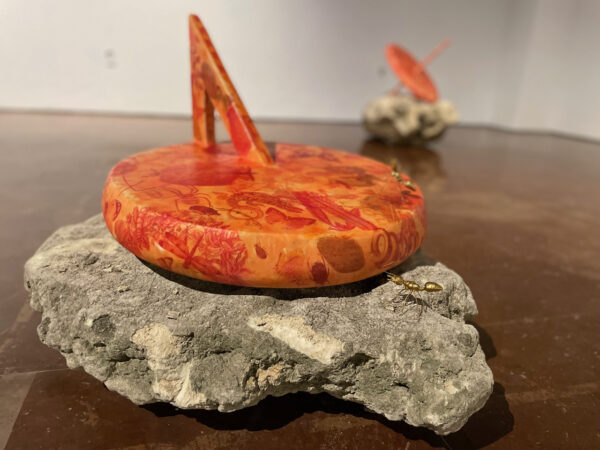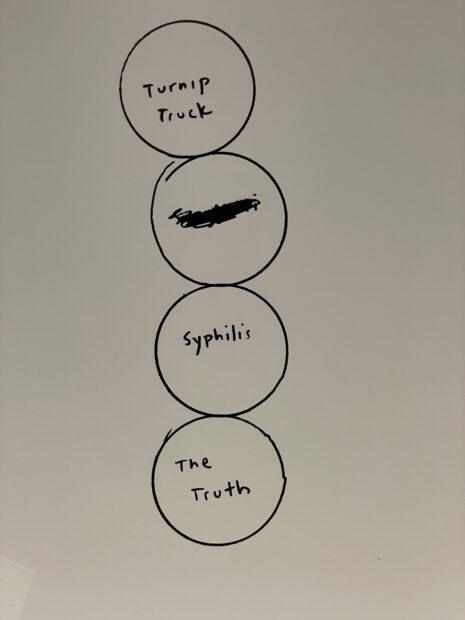
Sev Coursen, “Photo Booth Portraits,” 1978-1980, 23 images digitally scanned from analog photograph masters, 25 x 37 inches
In Parsley Space Rosemary Time, on view at Texas State Galleries in San Marcos, eight artists offer their personal take on the passage of time, and what it means to measure the infinite with only a finite glimpse.
The show moves counterclockwise around the gallery, somewhat ironically, starting with Sev Coursen’s Photo Booth Portraits: 23 pocket-size pictures of a 20-something Coursen, all taken between 1978 and 1980, that reveal the numerous iterations of youth. Though the artist’s hair and clothes vary in each photo, something in his eyes remains unchanged. Arranged in a six-by-four grid, the final photo is noticeably absent, as if there is still one more to be taken.
Kevin McNamee-Tweed’s displayed book The Circle Drawings (2013/2023) invites the viewer to flip through its pages of traced rings, each one containing a word or phrase. Some circles slightly overlap, others only touch — but the words all connect, even if their connection is convoluted, like “Turnip Truck,” “Syphilis,” and “The Truth.” (Elsewhere, a circle labeled “Time,” buoyed by two smaller ones — “Pain” and “Joy” — needs no further ado.) McNamee-Tweed’s wordplay extends to the show’s title, and though Parsley Space Rosemary Time isn’t a catchphrase taken from The Circle Drawings, it could just as easily appear in his book.

Betelhem Makonnen “untitled (ante-productivity exercises or moving time and space),” 2020, video installation, color video with sound, 25:40 mins (looped), monitor, rocks, four black-framed asynchronous commercial clocks, vinyl
Betelhem Makonnen’s three installations contemplate the relationship between deep-time geology and modern technology, including a glass encasement of wristwatches wrapped around various rocks. But let’s face it, rocks don’t mind if they’re running a bit behind. In a 25-minute video shown on a flatscreen monitor (perched on a pair of flat-ish stones) Makonnen can be seen rearranging mirrors on a floor while her reflection reveals itself from certain angles. Recording this futile activity is a fitting metaphor for the countless, often meaningless distractions that make up a lifetime. Above the video, four asynchronous clocks implore “Now Now Now Now.”
Andrea Martinez’s two monochromatic prints, Zenith/Nadir (2019), offer a little cosmic yin yang midway through the show. The diptych — one black and one white — sports a small circular opening in each center, suggesting an eclipse, or as she calls it, a “magical celestial sphere.” Their aesthetic balance instills immaculate order to an otherwise chaotic universe.

Cameron Cameron “Report, State” (installation view), 2022, resin, foam, image transfer, ceramic, images collected from Biodiversity Heritage Library at the University of Edinburgh, 24 x 24 x 14 inches
Cameron Cameron looks to nature within the phenomenon of time with three sculptural works: a Monarch butterfly clock and two sundials (also perched on rocks). Gilded ant figures make their way toward high noon on one of the sundials, covered in bright red images of flora and fauna that are not unlike ancient cave paintings. By using the earliest time-keeping device known to humans, the artist highlights the continual seasons and cycles that came long before and will carry on long after.
John Tennison’s two clock paintings — one digital, one analog — pinpoint specific moments with the simple, almost unconscious act of telling time. His digital clock, 12:34 (wish) (2023), is a poetic salute to the synchronistic magic that happens when the numbers line up just so. The other clock, forever frozen at 5:12, channels end-of-the-day deliciousness; a departure from one place to another. Both mechanisms act as gentle reminders of the objective reality we have constructed for ourselves.
But let’s leave the time-space continuum to Einstein and consider the possibility of a Playboy calendar in TJ Lemenski’s Birth Chart series, which features three separate wall calendars from 1984 (presumably the artist’s birth year, or an Orwellian reference) chronicling his adolescence with comic strips, sports, and sex. Partially collaged with pop culture phenomena — Garfield, the Brewers, half-naked cowboys and girls — these calendars mark important dates, and important milestones, where post-puberty is perhaps its own time-space continuum.

Meghan Shogan, “I Contained Multitudes,” 2023, marble, dried flowers, dirt, 13 x 10.25 x 3.25 inches
To end Parsley Space Rosemary Time with a gravestone seems wholly appropriate, if not oddly inspiring. Meghan Shogan’s I Contained Multitudes (2023), a marble slab carved with said phrase, rests on a pile of dried flowers and dirt. In time, it will come to this. So enjoy your turnip trucks and 12:34’s, your photo booth confessions and celestial spheres. Keep rearranging the mirrors of your own objective reality — the time is now now now now.
Parsley Space Rosemary Time is curated by Rebecca Marino. The exhibition is on view at TXST Galleries through November 7, 2023.



